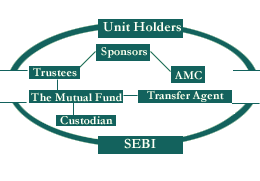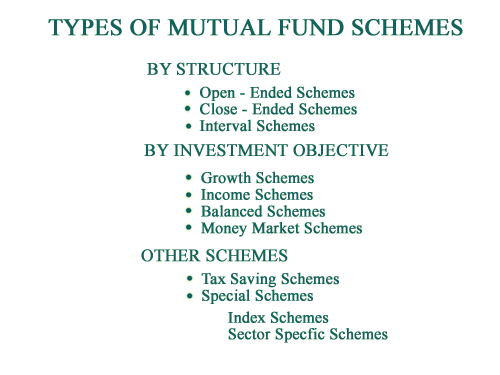|
| ORGANISATION OF A MUTUAL FUND |
There are many entities involved and the diagram below illustrates the organisational set up of a mutual fund: |
 |
| Organisation of a Mutal Fund |
|
 |
|
| ADVANTAGES OF MUTUAL FUNDS |
The advantages of investing in a Mutual Fund are:
Professional Management
Diversification
Convenient Administration
Return Potential
Low Costs
Liquidity
Transparency
Flexibility
Choice of schemes
Tax benefits
Well regulated
|
|
 |
|
| TYPES OF MUTUAL FUND SCHEMES |
Wide variety of Mutual Fund Schemes exist to cater to the needs such as financial position, risk tolerance and return expectations etc. The table below gives an overview into the existing types of schemes in the Industry. |
 |
 |
|
| FREQUENTLY USED TERMS |
|
| Net Asset Value (NAV) |
Net Asset Value is the market value of the assets of the scheme minus its liabilities. The per unit NAV is the net asset value of the scheme divided by the number of units outstanding on the Valuation Date. |
|
| Sale Price |
Is the price you pay when you invest in a scheme. Also called Offer Price. It may include a sales load. |
|
| Repurchase Price |
Is the price at which units under open-ended schemes are repurchased by the Mutual Fund. Such prices are NAV related. |
|
| Redemption Price |
Is the price at which close-ended schemes redeem their units on maturity. Such prices are NAV related. |
|
| Sales Load |
Is a charge collected by a scheme when it sells the units. Also called, ‘Front-end’ load. Schemes that do not charge a load are called ‘No Load’ schemes. |
|
| Repurchase or ‘Back-end’Load |
Is a charge collected by a scheme when it buys back the units from the unitholders. |
No comments:
Post a Comment